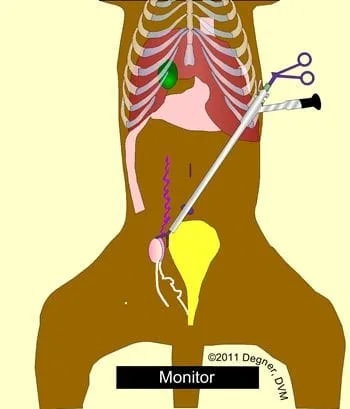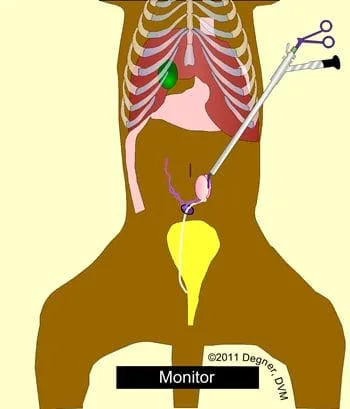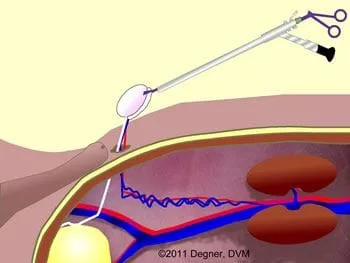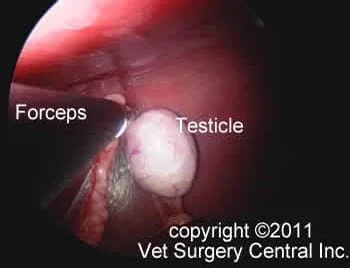Key Points
By 6 months of age both testicles should have descended from the abdomen into the scrotum
If left untreated, undescended testicles may develop cancer, which can be fatal in some cases
Laparoscopic surgery is the preferred method of treatment of this condition
Introduction
Before birth , the testicles of puppies and kittens are located within the abdomen. By six months of age, the testicles should have descended into the scrotum (sac between the hind limbs). If one or both testicles fail to descend into the scrotum, a condition called cryptorchidism is present.
Testicles are located in the scrotum, as they require a temperature that is lower than the core body temperature to function normally. Testicles located in the abdomen do not produce sperm, but do produce testosterone, a hormone responsible for masculine features. If both testicles are located within the abdomen, the animal will be sterile (cannot breed); however, frequently these animals have one testicle that has descended into the scrotum and can successfully sire litters of offspring. Because this condition has a genetic cause, affected animals should not be bred; the offspring are at risk of having the same condition.
Left untreated, affected pets can develop a cancer within the undescended testicle and this condition can be fatal due to hormonal imbalances that affect the bone marrow or due to spread of cancer to other internal organs.
Signs
Purebred animals are predisposed to cryptorchidism. Over represented breeds include Cocker Spaniels, Chihuahuas, Miniature Schnauzers, and Persian cats. The diagnosis of cryptorchidism is obvious: the lack of one or both testicles in the scrotum. If the neutering history of the pet is not known and no testicles are found within the scrotum, a blood test (sex hormone panel) can be run to see if the newly adopted pet is cryptorchid.
As mentioned, undescended testes are prone to developing cancer. The Sertoli cell tumor is the most common type of testicular cancer that develops in these cases. These tumors produce excessive amounts of estrogen, resulting in the development of female characteristics such as enlargement of the nipples, enlargement of the mammary glands, thin hair coat, a stripe of inflammation located on the prepuce, and pale gums due to anemia (bone marrow damage). Spread of the tumor to other organs in the body may result in weight loss, loss of appetite, malaise, breathing difficulties, and death.
Another complication of an undescended testicle is torsion or twisting of the blood vessels within the spermatic cord. When this occurs, the veins which normally drain blood from the testicle are occluded, but the artery feeding the testicle will continue to pump blood into the organ. This results in a painful, congested testicle. These patients may be lethargic, vomit, anorexic, and assume a praying stance with the forelimbs flat on the ground and hind end elevated (a sign of abdominal pain).

This dog was adopted as an older puppy and was believed to be neutered, as there were no testicles to be found externally. However, at 2 years of age, he developed bloody urine and straining to urinate. Ultrasound of the abdomen showed an enlarged prostate with small cystic changes due to prostatic hypertrophy and prostatitis.
Surgery
Traditional surgery requires a sizeable incision to locate and remove the undescended testicle. Traditional surgery also has been associated with serious life-altering or life-threatening complications. These problems include inadvertent removal of the prostate, inadvertent removal of the bladder, and damage to the ureters. Laparoscopic surgery greatly minimizes these types of surgical errors, because the surgeon can see what he/she is doing.
Laparoscopic surgery is performed on an outpatient basis; therefore, your companion will be able to go home late afternoon or early evening on the day of surgery. During surgery, a laparoscope (camera) is placed into the abdominal cavity via a 1 cm incision. The laparoscope has a channel in it, which allows the surgeon to pass a grasping instrument (forceps) without making another incision into the abdomen. Alternatively, some surgeons prefer to make two additional small incisions for placement of operating instruments. To complete the surgery, the testicle is grasped with forceps, pulled out of the abdominal incision, blood supply tied off, and the spermatic cord is cut. Because a cryptorchid testicle is typically much smaller than a testicle located within the scrotum, it usually can be pulled through the small portal incision.
This video clip shows a portion of the laparoscopic testicle removal. The camera is in the abdomen. A cauterizing forceps are used to divide the ligament that holds the testicle in the abdomen. Grasping forceps then retrieve the testicle. Complete pulling the testicle out of the abdomen is not seen.






Aftercare and expectations
To allow for a very smooth recovery at home, your pet should have a soft bed in a quiet room to encourage rest. Although laparoscopic cryptorchidectomy results in a fraction of the pain that is seen with traditional surgery, the prescribed analgesic medication(s) should be administered for a day or two. About half of a normal meal should be fed after your pet gets settled at home. Do not allow consumption of excessive amounts of water the evening after surgery (or vomiting likely will ensue). If your pet does not eat the regular diet, offer a cooked meal consisting of a 50:50 mixture of lean meat and a carbohydrate source such as rice, potato, or pasta. During the first evening, walk your dog outdoors three times for elimination purposes; your pet may need to urinate more than normal, as intravenous fluid were administered during the procedure (note: a full bladder can may your pet whine and seem in pain). Bowel movements might not be seen for a day or two after surgery. Do not allow your pet to lick the incision. Check the incision daily for signs of infection. Schedule an appointment to return to the surgeon two weeks after surgery for another evaluation of the healing process.
Dogs and cats recover very quickly following laparoscopic surgery and the prognosis is excellent, provided that the testicle has not developed a cancer which has metastasized to other internal organs. Even if the testicle has developed a tumor, the spread rate is still relatively low (about 10%). If permanent damage to the bone marrow has occurred from a hormonal imbalance, the prognosis for long-term survival is grave.
Benefits of the laparoscopic cryptorchidectomy vs. traditional open surgery
- Shorter surgery and anesthesia
- Less risk for abdominal hernias
- Much less bruising/swelling of the incision
- Less pain
- Quicker recovery
- Greatly reduced risk of surgical errors made (such as inadvertent removal of the bladder or prostate)
- Shortened hospital stay
rev 9/15/11


